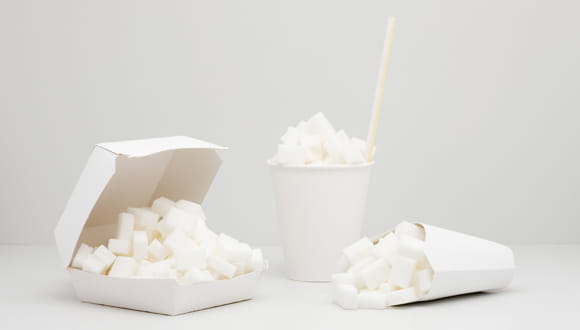Sugar is everywhere. It boosts the flavor of our food and drinks, it's in our beauty products and even finds its way into some medications. Let's face it: Sugar really does make life a little sweeter.
We all know how much kids love sugar, and honestly, many adults do, too. The truth is that sugar is not just something that tantalizes the taste buds — our brains actually need it to fuel vital functions. That's why having low blood sugar can cause shakiness, dizziness, confusion and unconsciousness.
Too much of a good thing
Americans definitely have a sweet tooth. We consume more sugar daily than any other country. According to the 2020 Dietary Guidelines for Americans, less than 6% of our diet should come from added sugar. In reality, however, a whopping 13% of our calories comes from added sugar. What does this look like? Well, with a 2,000-calorie-a-day diet, fewer than 120 calories should come from added sugar. Putting this into perspective, a 12 oz. can of Coke, with 39 g of sugar, has 156 calories from added sugar. So, it's really easy to see how quickly you can exceed the recommended daily allowance for added sugar with just one drink!
Added sugar tends to be refined sugar, which has little nutritional value. It doesn't include the natural sugars in unprocessed food and drinks that come from fruit, vegetables, dairy and grains that haven't had other nutrients stripped away. The body breaks down refined sugar more quickly, which can create unstable blood sugar levels.
There are many reasons to cut added sugar from your diet, including:
- Preventing tooth decay
- Improving overall health and nutrition
- Losing weight or preventing weight gain
- Stabilizing blood sugar
Consuming sugar increases your risk for some serious health conditions, including obesity, diabetes, cardiovascular disease, nonalcoholic fatty liver disease and some cancers.
Enjoying foods with less sugar isn't going to happen overnight if you've been living on sugar overload. And, you've probably been in the grips of this lifelong love affair with sweetness since someone first gave it to you as a baby. Unfortunately, you will have to retrain your brain to recognize what food should taste like without all the extra sugar. Some well-earned advice: Don't go cold turkey by trying to eliminate all sugar from your diet — trying cutting back just a little bit at a time.
Video: Does sugar make you hyper?
How to cut sugar out of your diet
If you are ready to cut some sugar out of your diet, here are four tips to help you along the way:
1. Reduce the added sugar
Check the nutrition label for added sugar. Processed foods typically have added sugar to enhance the flavor, especially in reduced-fat foods. In fact, low-fat foods often contain more sugar, even though they may have fewer calories. Instead, try foods with no sugar added and make the switch. On food labels, look for sugar alcohols, which are used to sweeten, but don't contain the calories. However, because they are not fully absorbed by the small intestines, sugar alcohols can cause gastrointestinal distress, such as diarrhea, gas and bloating.
2. Switch to a sweetener
Switching to a zero-calorie sweetener can satisfy your sweet tooth without adding sugar or calories — which works especially well for people who have diabetes or who are dieting. There are seven FDA-approved nonnutritive sweeteners that are commonly used: acesulfame-K, aspartame, neotame, saccharin, stevia, sucralose and monk fruit. Because they have an aftertaste, these sweeteners may not be for everyone.
Although there are benefits of using sweeteners, don't let the sweet taste fool you. Studies suggest that people who use these sweeteners may be sabotaging their diet and increasing their risk of type 2 diabetes. That's because using nonnutritive sweeteners often makes you continue to crave sweets because your brain doesn't register it as satisfying. Also, you may think that because you are saving calories by using a sweetener, it's okay to eat or drink something unhealthy.
3. Make a swap
To be fair, table sugar does have some nutritional value. It's a source of simple carbohydrates and energy. But, that's it. To get more bang for the buck while getting your sugar fix, trying making these swaps:
- Eat fruit instead of drinking the juice. Not only does fruit contain sugar in the form of fructose, but it can also be a source of fiber and vitamins. The fiber and complex carbs help you feel full and are better for stabilizing blood glucose levels.
- Try unsweetened dark chocolate instead of milk chocolate.
- Give in to your soda craving by switching to sparkling water. If you need to add some flavor, try adding a slice of lemon or other fruit.
- Make yourself dessert. For an alternative to ice cream, try freezing a ripe banana and then blending it until it's smooth and creamy.
Thinking about using another natural sweetener, such as honey, instead of white sugar? Although honey has vitamins and minerals, and doesn't raise blood sugar as quickly as white sugar, it also has more calories. But because it is sweeter than white sugar, you may end up using less of it.
4. Reduce serving sizes
One way to decrease the amount of sugar in your diet is to simply cut back.
- If you must satisfy your sweet tooth with something, well, sweet, try eating just a little bit of it — like just a spoonful of ice cream instead of an entire pint. Or, you can just buy a mini-ice-cream cup instead.
- Downsize that large cup of flavored gourmet coffee by opting for a smaller size or asking the barista to cut the amount of added syrup in half. Or better still, make your java at home so that you can better control what goes into it.
- Split your dessert with someone else. Or, opt for a sugar-free or no-sugar-added dessert, if possible.


